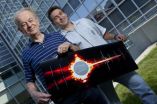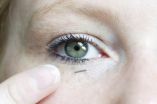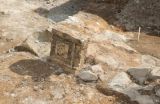(Press-News.org) Rust – iron oxide – is a poor conductor of electricity, which is why an electronic device with a rusted battery usually won't work. Despite this poor conductivity, an electron transferred to a particle of rust will use thermal energy to continually move or "hop" from one atom of iron to the next. Electron mobility in iron oxide can hold huge significance for a broad range of environment- and energy-related reactions, including reactions pertaining to uranium in groundwater and reactions pertaining to low-cost solar energy devices. Predicting the impact of electron-hopping on iron oxide reactions has been problematic in the past, but now, for the first time, a multi-institutional team of researchers, led by scientists at the U.S. Department of Energy (DOE)'s Lawrence Berkeley National Laboratory (Berkeley Lab) have directly observed what happens to electrons after they have been transferred to an iron oxide particle.
"We believe this work is the starting point for a new area of time-resolved geochemistry that seeks to understand chemical reaction mechanisms by making various kinds of movies that depict in real time how atoms and electrons move during reactions," says Benjamin Gilbert, a geochemist with Berkeley Lab's Earth Sciences Division and a co-founder of the Berkeley Nanogeoscience Center who led this research. "Using ultrafast pump-probe X-ray spectroscopy, we were able to measure the rates at which electrons are transported through spontaneous iron-to-iron hops in redox-active iron oxides. Our results showed that the rates depend on the structure of the iron oxide and confirmed that certain aspects of the current model of electron hopping in iron oxides are correct."
Gilbert is the corresponding author of a paper in the journal Science that describes this work. The paper is titled "Electron small polarons and their mobility in iron (oxyhydr)oxide nanoparticles." Co-authoring the paper were Jordan Katz, Xiaoyi Zhang, Klaus Attenkofer, Karena Chapman, Cathrine Frandsen, Piotr Zarzycki, Kevin Rosso, Roger Falcone and Glenn Waychunas.
At the macroscale, rocks and mineral don't appear to be very reactive - consider the millions of years it takes for mountains to react with water. At the nanoscale, however, many common minerals are able to undergo redox reactions - exchange one or more electrons - with other molecules in their environment, impacting soil and water, seawater as well as fresh. Among the most critical of these redox reactions is the formation or transformation of iron oxide and oxyhydroxide minerals by charge-transfer processes that cycle iron between its two common oxidation states iron(III) and iron(II).
"Because iron(II) is substantially more soluble than iron(III), reductive transformations of iron(III) oxide and oxyhydroxide minerals can dramatically affect the chemistry and mineralogy of soils and surface," Gilbert says. "In the case of iron(III) oxide, the reduction to iron(II) can cause mineral dissolution on a very fast timescale that changes the mineralogy and water flow pathways. There can also be a mobilization of iron into solution that can provide an important source of bioavailable iron for living organisms."
Gilbert also noted that many organic and inorganic environmental contaminants can exchange electrons with iron oxide phases. Whether it is iron(III) or iron(II) oxide is an important factor for degrading or sequestering a given contaminant. Furthermore, certain bacteria can transfer electrons to iron oxides as part of their metabolism, linking the iron redox reaction to the carbon cycle. The mechanisms that direct these critical biogeochemical outcomes have remained unclear because mineral redox reactions are complex and involve multiple steps that take place within a few billionths of a second. Until recently these reactions could not be observed, but things changed with the advent of synchrotron radiation facilities and ultrafast X-ray spectroscopy.
"Much like a sports photographer must use a camera with a very fast shutter speed to capture an athlete in motion without blurring, to be able to watch electrons moving, we needed to use a exceedingly short and very bright (powerful) pulse of X-rays," says Jordan Katz, the lead author on the Science paper who is now with Denison University. "For this study, the X-rays were produced at Argonne National Laboratory's Advanced Photon Source."
In addition to short bright pulses of X-rays, Katz said he and his co-authors also had to design an experimental system in which they could turn on desired reactions with an ultrafast switch.
"The only way to do that on the necessary timescale is with light, in this case an ultrafast laser," Katz says. "What we needed was a system in which the electron we wanted to study could be immediately injected into the iron oxide in response to absorption of light. This allowed us to effectively synchronize the transfer of many electrons into the iron oxide particles so that we could monitor their aggregate behavior."
With their time-resolved pump-probe spectroscopy system in combination with ab initio calculations performed by co-author Kevin Rosso of the Pacific Northwest National Laboratory, Gilbert, Katz and their colleagues determined that the rates at which electrons hop from one iron atom to the next in an iron oxide varies from a single hop per nanosecond to five hops per nanosecond, depending on the structure of the iron oxide. Their observations were consistent with the established model for describing electron behavior in materials such as iron oxides. In this model, electrons introduced into an iron oxide couple with phonons (vibrations of the atoms in a crystal lattice) to distort the lattice structure and create small energy wells or divots known as polarons.
"These electron small polarons effectively form a localized lower-valence metal site, and conduction occurs through thermally-activated electron hopping from one metal site to the next," Gilbert says. "By measuring the electron hopping rates we were able to experimentally demonstrate that iron(II) detachment from the crystal is rate-limiting in the overall dissolution reaction. We were also able to show that electron hopping in the iron oxides is not a bottleneck for the growth of microbes that use these mineral as electron acceptors. The protein-to-mineral electron transfer rate is slower."
Katz is excited about the application of these results to finding ways to use iron oxide for solar energy collection and conversion.
"Iron oxide is a semiconductor that is abundant, stable and environmentally friendly, and its properties are optimal for absorption of sunlight," he says. "To use iron oxide for solar energy collection and conversion, however, it is critical to understand how electrons are transferred within the material, which when used in a conventional design is not highly conductive. Experiments such as this will help us to design new systems with novel nanostructured architectures that promote desired redox reactions, and suppress deleterious reactions in order to increase the efficiency of our device."
Adds Gilbert, "Also important is the demonstration that very fast, geochemical reaction steps such as electron hopping can be measured using ultrafast pump-probe methods."
INFORMATION:
This research was supported by the U.S. Department of Energy's Office of Science, which also supports the Advanced Photon Source.
Lawrence Berkeley National Laboratory addresses the world's most urgent scientific challenges by advancing sustainable energy, protecting human health, creating new materials, and revealing the origin and fate of the universe. Founded in 1931, Berkeley Lab's scientific expertise has been recognized with 13 Nobel prizes. The University of California manages Berkeley Lab for the U.S. Department of Energy's Office of Science. For more, visit www.lbl.gov.
DOE's Office of Science is the single largest supporter of basic research in the physical sciences in the United States, and is working to address some of the most pressing challenges of our time. For more information, please visit the Office of Science website at science.energy.gov/.
Rust never sleeps
Berkeley Lab-led observations of electron hopping in iron oxide hold consequences for environment and energy
2012-09-07
ELSE PRESS RELEASES FROM THIS DATE:
Alzheimer's experts from Penn Summit provide strategic roadmap to tackle the disease
2012-09-07
PHILADELPHIA –This week, a strategic roadmap to help to the nation's health care system cope with the impending public health crisis caused Alzheimer's disease and related dementia will be published in Alzheimer's & Dementia: The Journal of the Alzheimer's Association. The plan aims to link the latest scientific findings with clinical care and bring together patients, families, scientists, pharmaceutical companies, regulatory agencies, and advocacy organizations behind a common set of prioritized goals. The consensus document is the outcome of a June meeting of leading ...
Lack of support for 'ring-fencing' cancer drugs fund revealed
2012-09-07
The public oppose the cancer drugs fund but support the new pricing system for branded medicines, according to a new study.
When asked if the NHS should pay more for cancer drugs compared to medicines for an equally serious condition, the majority of 4,118 people surveyed across Britain said it shouldn't.
Medicines were favoured, however, if they met the criteria by which the value of new medicines is to be assessed as part of the value-based pricing scheme, due to be introduced from January 2014. Treatments were preferred if they were for severe diseases, if they ...
Influenza research: Can dynamic mapping reveal clues about seasonality?
2012-09-07
MEDFORD/SOMERVILLE, Mass. - Influenza outbreaks in the United States typically begin with the arrival of cold weather and then spread in seasonal waves across geographic zones. But the question of why epidemics can vary from one season to the next has baffled scientists.
In a paper titled "Deviations in Influenza Seasonality: Odd Coincidence or Obscure Consequence," Elena Naumova, Ph.D., professor of civil and environmental engineering at Tufts School of Engineering, and collaborators from the U.S. and India suggest that the search for answers has been thwarted, in ...
Needle beam could eliminate signal loss in on-chip optics
2012-09-07
Cambridge, Mass. – September 7, 2012 - An international, Harvard-led team of researchers have demonstrated a new type of light beam that propagates without spreading outwards, remaining very narrow and controlled along an unprecedented distance. This "needle beam," as the team calls it, could greatly reduce signal loss for on-chip optical systems and may eventually assist the development of a more powerful class of microprocessors.
Based at the Harvard School of Engineering and Applied Sciences (SEAS) and the Laboratoire Interdisciplinaire Carnot de Bourgogne, CNRS, in ...
The birdy smell of a compatible partner
2012-09-07
New evidence shows that birds may choose their mate with the help of smell. They prefer a dissimilar mate because this gives their young a more efficient immune system. This has been shown in a new study by researchers from Lund University in Sweden, in a Swedish-French collaboration.
Humans and many animals can choose a suitable mate by smell. Choosing a mate with the right smell can give the offspring an efficient immune system. This is because each individual's smell can be said to reflect information on the individual's genes. By finding the mate whose genes best ...
Measuring glucose without needle pricks
2012-09-07
Sticking yourself in the finger day after day: For many diabetics, this means of checking blood glucose is an everyday part of life. Especially for patients with Type-1 diabetes, who always have to keep a close eye on their levels, since their bodies are incapable of producing the insulin to break down the glucose in the blood. Several times a day, they have to place a tiny drop of blood on a test strip. It is the only way they can ascertain the blood glucose value, so they can inject the correct amount of insulin needed. And this pricking is not only a burdensome: it may ...
Unemployment causes more mental health problems among Somalis in London than in Minneapolis
2012-09-07
Somali immigrants to the UK and USA appear to integrate better and have fewer mental health problems if they are allowed to work and they receive practical support during the first few years of their time in the new country, according to a study led by researchers at Queen Mary, University of London (UK) and published in BioMed Central Public Health today (Friday). [1]
The study used a survey and focus groups to investigate the experiences of Somalis living in London (UK) and Minneapolis (USA). After adjusting for various factors such as age, sex and marital status, the ...
Archaeologists uncover 'lost garden' in quest for Richard III
2012-09-07
Archaeologists from the University of Leicester who are leading the search for the lost grave of King Richard III announced today that they have made a new advance in their quest.
They have uncovered evidence of the lost garden of Robert Herrick – where, historically, it is recorded there was a memorial to Richard III.
Now the 'time tomb team' as they have become to be known has discovered paving stones which they believe belong to the garden.
The University of Leicester is leading the archaeological search for the burial place of King Richard III with Leicester City ...
Premier global health journal, The Lancet, releases series on universal health coverage
2012-09-07
Washington D.C., September 7, 2012 – Every year 100 million people are pushed into poverty because they have to pay for health services directly. With support from the Rockefeller Foundation, Results for Development Institute has partnered with the world's premier global health journal, The Lancet, on a special collection of papers exploring the social, political, and economic issues around the global movement towards universal health coverage (UHC) – defined by the World Health Organization as everyone in a population having access to appropriate, promotive, preventive, ...
Antibiotic therapy improves moderate exacerbations of mild-to-moderate COPD
2012-09-07
Antibiotic treatment with amoxicillin/clavulanate improves moderate exacerbations in patients with mild-to-moderate chronic obstructive pulmonary disease (COPD) and significantly prolongs the time between exacerbations, according to a new study from researchers in Spain.
"The existing evidence for antibiotic therapy in non-severe exacerbations of COPD is weak," said lead author Carl Llor, MD, PhD of the University Rovira i Virgili in Tarragona, Spain. "The results of our multicenter, randomized, double-blind, placebo-controlled trial show that antibiotic treatment is ...
LAST 30 PRESS RELEASES:
Novel endocrine therapy giredestrant improves disease-free survival over standard of care for patients with early-stage breast cancer in phase III lidERA trial
Gen Z views world as "scary place" with growing cynicism about ability to create change
Biosensor performance doubled – New applications possible
Leveraging incomplete remote sensing for forest inventory
Key chemical in dark chocolate may slow down ageing
New 15-minute hepatitis C test paves the way for same-day treatment
Uranus and Neptune might be rock giants
Magnetically actuated soft electrodes for multisite bioelectrical monitoring of ex vivo tissues
FAU engineers decode dementia type using AI and EEG brainwave analysis
Carrier-free peptide–daunorubicin–small interfering RNA nanoassembly for targeted therapy of acute myeloid leukemia
Global Virus Network announces appointment of new board members
Artificial beaver dams show promise in offsetting climate change effects
Could hidden infections be fueling long COVID?
Targeted oxygen for initial resuscitation of preterm infants
Researchers develop models to help diagnose ALS earlier through blood biomarkers
Jeonbuk National University researchers develop novel eco-friendly and photo-switchable smart adhesives
Magnetic ordering induces Jahn–Teller effect in spinel-type compounds
A mitochondrial protein may hold the secret to longevity, new study finds
Study shows how everyday repairs sustain autonomy in a Japanese squat
Ancient manatee relative reveals that sea cows have engineered the Arabian Gulf’s seagrass ecosystems for over 20 million years
Fecal tests reveal active termite attacks
Uterine fibroids linked to elevated heart disease risk
Dual use of cigarettes and vapes can reduce risks of smoking and help smokers quit
New bioelectronics device based on hydrogel- elastomer conductive nanomembranes
More yield through heterosis: IPK research team decodes gene interaction
James Webb telescope reveals spectacular atmospheric escape
ICE-CSIC leads a pioneering study on the feasibility of asteroid mining
Dramatic rise in young people using mental health services
Be careful trusting TikTok for gout advice
A study by the University of Seville links the vanishing of the specific heats at absolute zero with the principle of entropy increase
[Press-News.org] Rust never sleepsBerkeley Lab-led observations of electron hopping in iron oxide hold consequences for environment and energy



